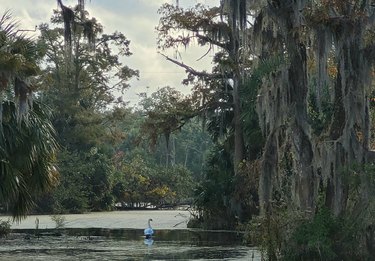
You can identify Spanish moss (Tillandsia usneoides) in trees by looking for weeping leaves that are silver or gray in color. While it is easy to think that the Spanish moss is harming the tree by feeding off it, the reality is much more interesting. Despite the name, Spanish moss is not native to Spain. The Spanish moss range map includes much of the Southeastern United States and South America, and you may find this plant growing in U.S. Department of Agriculture plant hardiness zones 8 to 11.
Fun Facts About Spanish Moss
Video of the Day
Where does Spanish moss grow? In the Southeastern states, you will often find this plant on oak trees (Quercus spp., USDA zones 3-9) and cypress trees (Chamaecyparis spp., USDA zones 4-8), but Spanish moss is not a parasitic plant or a type of moss at all. In fact, it is an air plant and does not have roots but instead grows on other trees, relying on them to provide support.
Video of the Day
How does Spanish moss get nutrients if it is not getting them from the tree on which it grows? The leaves and stems of the plant are covered in scales that have the ability to absorb moisture and nutrients from the air and rain. They may also feed on debris on tree branches. To thrive, Spanish moss requires humid, warm conditions with minimal pollution.
How does Spanish moss spread? Where does Spanish moss come from? Spanish moss is propagated by seed carried on the wind as well as pieces of stem transported by birds and other animals.
Spanish Moss and Tree Health
Is Spanish moss bad for trees? It is easy to see the thick Spanish moss hanging from branches and assume it is damaging the tree. In some cases, the moss can get heavy enough to damage branches and may restrict leaf growth in the immediate area, but it does not inflict any other injury on the tree.
This is confusing to some people since the plants are often found on dead or dying trees. Spanish moss does grow best in full sun to part shade. Many healthy, thriving trees have a thick canopy of leaves that prevent sunlight from reaching the Spanish moss, thus preventing it from growing. However, if the tree has a thinning canopy due to damage or disease, the increased sunlight can encourage Spanish moss to grow.
Spanish Moss Benefits and Uses
Beyond its striking appearance, Spanish moss plays an important ecological role. It is used as a shelter for a variety of animals, including many species of amphibians, bats and reptiles. Birds may also collect the moss and use it to build nests.
Does Spanish moss have bugs? It rarely suffers from disease or pest infestations, although Spanish moss chiggers may be a concern. While they do not necessarily harm the plant, they can cause irritation if you touch the moss.
Humans also found uses for Spanish moss. Before the development of synthetic materials, it was used as packing material, insulation and stuffing for cushions. It can also be used in floral arrangements and arts and crafts projects.